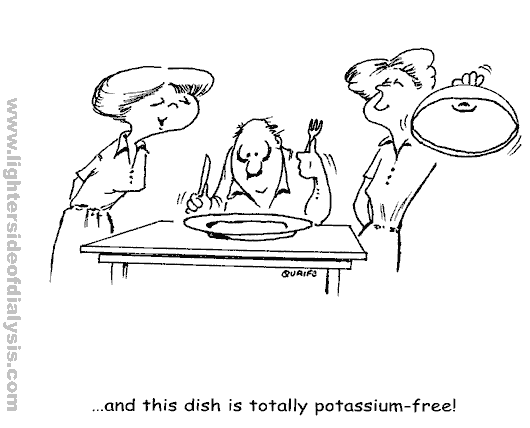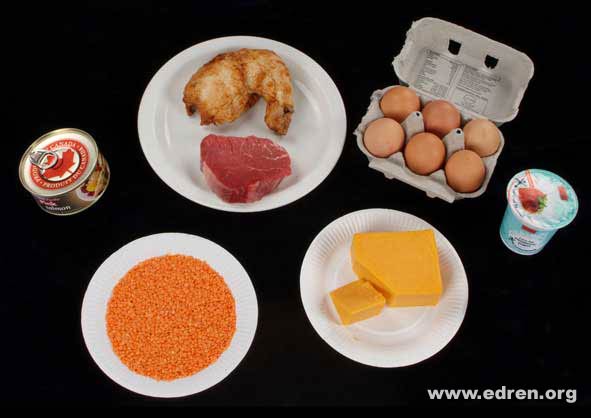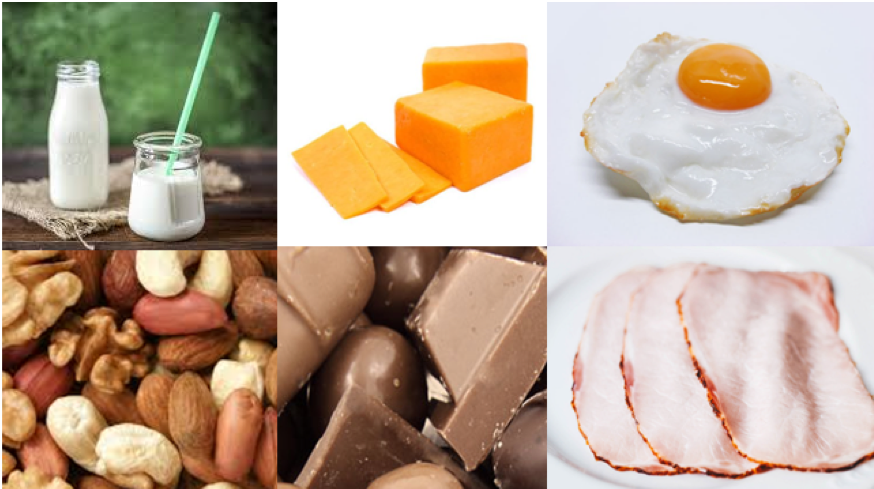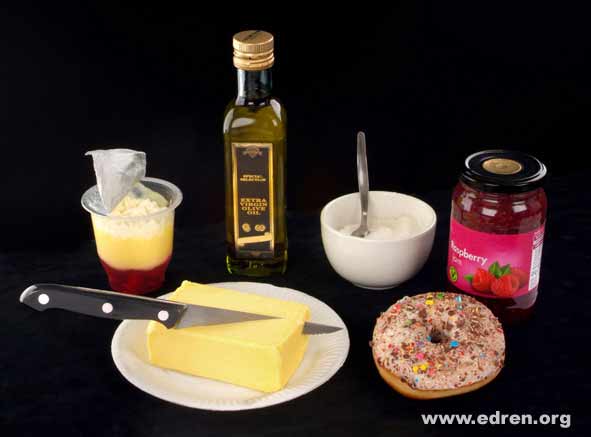For downloads on Eating out, our Festive supplement, and Adapting your own recipes,
see the foot of this page
Contents
What’s in food?
Excessive intake of protein must be avoided in CKD. Historically and on rare occassions a low protein diet has been advised for patients with renal failure. We don’t usually do this. This is explained in diet for the failing kidney. edit
- In CKD protein intake should be moderate – not high, not too low. Read more about diet for the failing kidney and in CKD.
- On haemodialysis a slightly higher protein intake is recommended. Read more about diet on haemodialysis.
- On PD a higher protein intake is recommended due to a small loss of protein from the drained fluid (dialysate).
Read more about diet on CAPD.
Sodium
Common salt is sodium chloride. Modern diets contain too much salt, and sick kidneys cannot cope. A high salt intake can lead to high blood pressure and to fluid retention and overload. Many blood pressure tablets only work properly if combined with a reduced salt intake.In most patients with kidney disease or on dialysis we recommend keeping salt down to ‘no added salt’ levels of less than 100mmol/day (6g of salt, which is just over 2g of sodium – still a lot more than we need). This diet allows small amounts of salt to be used in cooking, but means limiting very salty foods, processed or convenience foods and choosing bread with less than 0.4g salt per slice and not adding salt to food at the table. The less salt the better!
Salt substitutes such as ‘Lo-Salt’ are not suitable for patients with renal failure, because they contain large amounts of potassium. Sodium can also be found in some medicines. Effervescent or soluble painkillers are a particular problem – don’t use them if you need to control your salt intake. A really good website is www.saltaction.org.uk which has lots of helpful tips and resources.
Potassium
A typical daily intake of potassium in the UK is 50-150mmol.
A low potassium diet should ideally be less than 65mmol.
Potassium is present in most foods but in higher amounts in fruit & vegetables.
Download a short leaflet about Cutting Down Potassium (pdf file) – a short list of foods to watch out for if your potassium is high.
Potassium levels can be high in severe renal failure and on dialysis, but potassium intake should not be restricted routinely – only if tests show high potassium levels. This is because potassium-containing foods include many healthy foods. Very high potassium levels (e.g. 6.5 or higher) can be dangerous as they can lead to a cardiac arrest. As well as diet, some drugs can cause high potassium in patients with CKD, and there are some other causes. More detail is available from the links below.
Read about diet for the failing kidney | Read about diet on haemodialysis | Read about diet on CAPD
| Click here to download a Festive Tips Diet Sheet on Potassium (pdf) |
Fluid (liquids)
About fluid
Most people drink 1-2 litres a day and don’t need to reduce fluid intake until kidney disease is very severe. However if you are a dialysis patient who doesn’t produce much urine, you have to cut down the amount you drink, otherwise you will accumulate fluid.
Click here to see an animation of what happens if a haemodialysis patient drinks too much fluid, from the Kidney Patient Guide (Wrexham Maelor Hospital, Wales). You need Flash Player on your PC (or Mac) to see it work (links to get this free are provided).
Download a short leaflet about fluid (pdf file) – how to measure it without jugs, and hints for fluid control.
Cartoon by Peter Quaife from The Lighter Side of Dialysis (Jazz Communications), with permission.
All drinks contain mostly water. Fluids refer to all drinks taken per day. If you are not on dialysis, you should not restrict fluids unless you have a particular problem with fluid overload. For most patients there is no special benefit from drinking extra water. If you have a problem with fluid retention, it is very important to limit. It is impossible to control your fluid intake if you are taking too much salt – you just get too thirsty. On haemodialysis the fluid allowance for each patient often needs to be quite strictly controlled. Read more about diet on haemodialysis. On peritoneal dialysis things may be a little easier. Read more about diet on PD.
Phosphate
In the long-term, Having a high phosphate level is less good for your health and can lead to serious bone disease and damage to your blood vessels and joints. Day-to-day, it can make you feel very itchy. Having a high phosphate level for many years can limit how long you might survive on dialysis. All patients with advanced kidney disease should aim to have a phosphate level less than 1.7mmol/l.
The foods that are the highest in phosphate are those that contain phosphate additives. These tend to be found in foods such as processed meats, processed cheeses, products coated in batters or breadcrumbs, dark coloured fizzy drinks and in some shop-bought bakery products.
Dairy foods also contain a high amount of phosphate but have other benefits to health. These foods should not be avoided but reduced in the diet if you take a lot of them.
Download a short leaflet about the main sources of phosphate in food.
Energy
Too few calories lead to the breakdown of muscle to provide energy. If you lose muscle you become weak and debilitated. Once this has happened it takes months to recover strength. Appetite is decreased in many patients with kidney disease, and in some it is necessary to provide nutritional supplements.
Malnutrition can be a serious problem in severe kidney disease and in some dialysis patients. It tends to be a particular problem in people who have had other illnesses, or a complicated time as they have developed kidney failure. Early help from expert dietitians is very valuable if this occurs.
If you are above a healthy weight, then adapting your diet to achieve weight loss can be particularly challenging if you also have kidney disease. This advice leaflet gives information about how to use diet and exercise to achieve a healthy weight in kidney disease.
Further information
Our Puzzle Book (download below) won a prize in 2011. Use it to learn more about what’s in food. An excellent resource for patients is the information from the Arizona Dietetic project. The NKF(US) diet resources look good and include a whole cookbook. A quite good list of further info links from the Life Options site (a commercially sponsored site about living on dialysis)
Look up a food to find what’s in it – two links that give quite technical and detailed information, from the USDA or from the Nephron Info Centre Foodvalues site. These are especially suitable for professionals.
History: Read about the history of diet in renal disease from our pages on the History of Dialysis and Transplantation in Edinburgh.
Acknowledgements: The authors of this page were Elizabeth Sloan, Hazel Elliott and Susan Reed. It was first published in January 2001 and extensively revised in August 2006 then reviewed again by Susan Reed in May 2010. The date is was last modified is shown in the footer.






